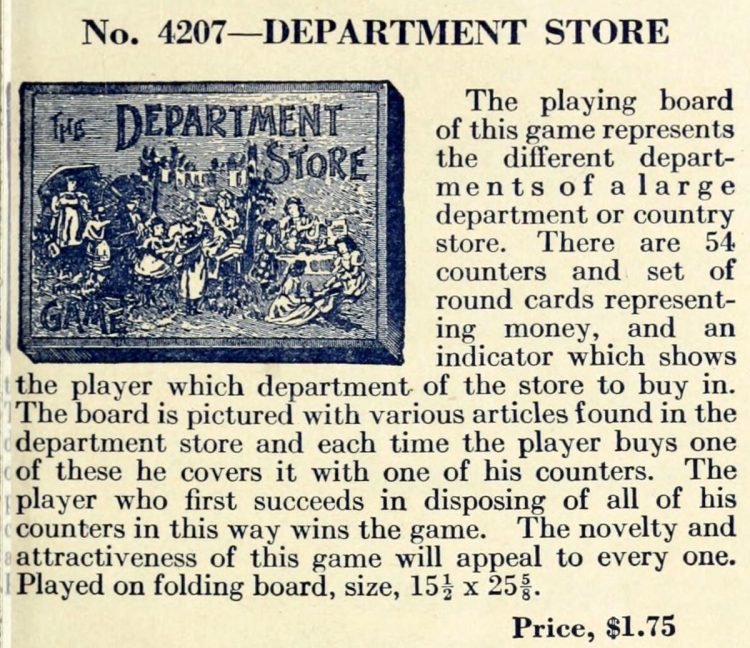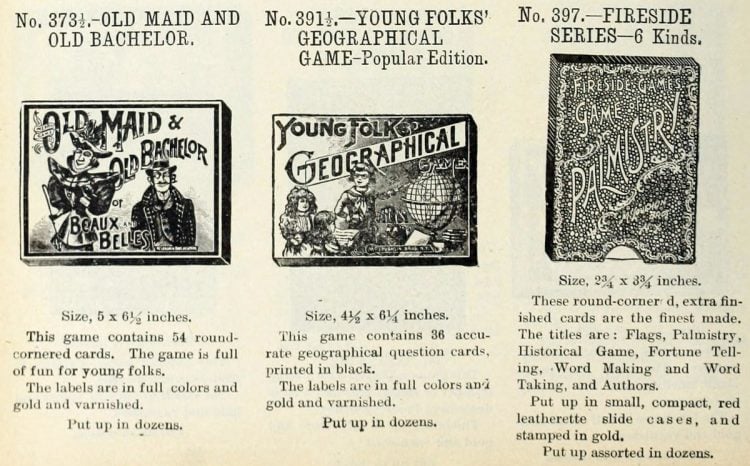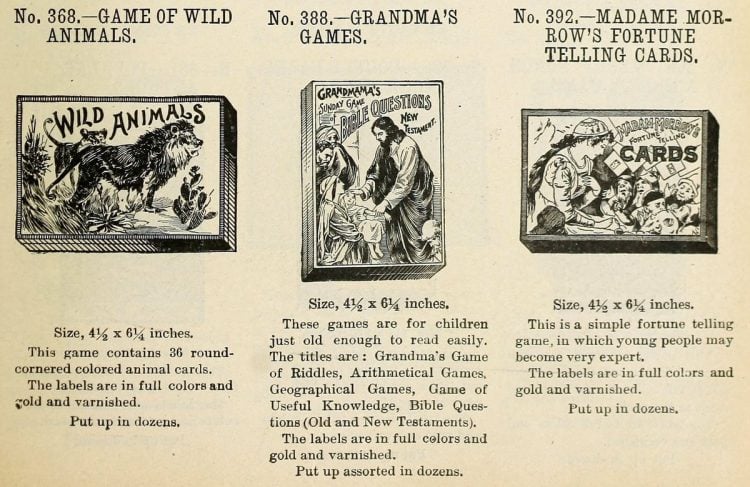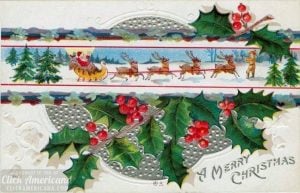Antique board games people played long before Monopoly
According to the article we found from 1975 (reprinted below), board games weren’t mass-produced until after the Civil War. Before that, children were expected to spend their time on more practical pursuits. Once companies like Milton Bradley and Parker Brothers started making games commercially, they became a staple in American homes.

Some games reflected everyday life, like Country Auction, where players bid on household goods, or The Auto Game, which sent them down a road full of obstacles like broken axles and flat tires. Lotto was an early version of bingo, and Peter Coddle was a storytelling game that could still be fun today. Collectors prize these old games, especially when they still have their original pieces, like bone chips instead of plastic in Tiddledy Winks.
Antique board games may not be as common today, but they offer a glimpse into how people entertained themselves in a time before screens. Some, like Old Maid and Jack Straws, are still around, while others remain rare finds in antique shops.
We’ve gathered vintage photos and articles about these old-fashioned games. If you’re curious about how past generations played, take a look — you might even find one worth reviving.
Antique board games & card games: Simpler times & simpler amusements
From an article by Lilian Jackson Braun – Detroit Free Press (Michigan) November 3, 1975
Who remembers Tiddledy Winks, Peter Coddle, Shoot the Hat, and Snap? They were pastimes that provided hours of entertainment before the days of radio and TV — even before Monopoly.
“They were uncomplicated,” said Warren Stephens, who collects Victorian games. “Simpler times, simpler amusements.”
“Games were not made commercially until after the Civil War,” he said. “They didn’t believe in children wasting their time. You can date the games by the clothing styles on the boxes. Collectors go for the colorful boxes.”
Many of the cardboard containers are remarkably well-preserved. “Kids took better care of their toys then.”
AN EARLY ITEM in Stephens’ collection is a set of Crandall’s building blocks. In 1887, Crandall was manufacturing an interlocking wooden box to hold “the new game of croquet” when his children contracted scarlet fever.
He took some of the wooden components home for his children to play with, and the doctor attending them said: “Would you make a set for my own children?” Stephens said, “Crandall went on to build a toy empire.”
“The old games of Milton Bradley and Parker Brothers are also highly collectible.”
Another choice item in the collection is called The New Game of Tiddledy Winks, with chips made of bone (not plastic) and with a real little woven basket to catch them. “These little baskets sometimes turn up in antique shops,” Stephen said, “and people don’t know what they are.”

There are early Jack Straws, Old Maid, Buffalo Hunt, Soldiers Five, the Santa Claus card game, Lotto, and the ludicrous adventures of Peter Coddle. “Lotto was the first bingo game. Peter Coddle is a game that could be revived; our kids play it.”
In the Country Auction game, a butter churn goes for $2.50, a turkey gobbler for $2, a plow for $10. In the Auto Game, the players spin a dial (on dice) and move counters along a roadway fraught with catastrophes: punctured tire, broken axle, hot cylinder, collision.
STEPHENS COLLECTS nothing later than World War II. “Monopoly came after that,” he said, “but it is the most popular game of all time.”
The games sometimes bear their original prices: 8 cents, 17 cents, or an exorbitant 39 vents.
“Often we get one where Mother has sewn the box to repair it. Boxes can be cleaned carefully with wallpaper cleaner or repaired with a little white glue, but never patch them with Scotch tape. You can’t get it off without damaging the box.”
As collectibles, games are still reasonable, compared to such runaway favorites as cast iron toys. “You can get a Victorian game for $5,” the collector said, “and you hardly ever see them over $20.”

Old-fashioned games: Fortunes in small things (1910)
The San Francisco Call (San Francisco, California) January 08, 1910
“The philosophical maxim, “Nothing is small or insignificant,” is strikingly realized in the history of what seem to be petty inventions.
The man who patented the idea of attaching rubber tips to lead pencils realized over $200,000 by his invention. The miner who first attached a metal rivet at each end of the mouth of the trousers pockets, to resist the strain of heavy bits of ore, made more money than if he had found a gold mine; while he who first devised the small metal plates to protect shoe heels realized $250,000 in a few years.

The glass bells to hang over gas jets, and thus protect the ceiling from smoke, made a large fortune for their inventor; while the inventor of the roller skate made over $1,000,000. The copper tips to shoes made their inventor a millionaire; and the gimlet screw has piled up a dozen fortunes for its proprietors.
Even toys have made their inventors rich, and fortunes have, been realized from the dolls that close their eyes, dolls that cry, balls with return string and puzzles; in fact, any device that sells in great quantities, however insignificant it may seem, is certain to bring very large returns to its owner.
It is noticeable, however, that originality is essential to success in all small inventions, especially toys and games.
The great inventions of the country, such as the steam engine, steamship, spinning machines and many others, are continually being perfected, until they now bear little resemblance to the first model; but the public does not seem to care for any improvement in small inventions.

Two of the greatest selling toys of the present century were the “Fifteen puzzle” and “Pigs in clover.” They sold by the millions, and were followed by a number of imitations, all very cleverly designed, and some equal in ingenuity to the originals, but they did not sell at all. The public curiosity had evidently exhausted itself and could not be revived.
There is also a grout deal of chance in the success of these little things, and the ephemeral character of their popularity shows that they have no basis of real merit. In a single year, perhaps inside of six months, the craze runs its course.

Wild West Game – Race Around the World – Messenger Boy

Day at the Circus – Uncle Sam’s Mail – Parlor Game of Golf

Mother Goose Games – Mademoiselle Lenormand’s Fortune-Telling Game – Punch & Judy

Mother Goose’s trip to the Moon and Egypt – Red Riding Hood and Slide – Baseball and hunting and trapping

Mail, express and accommodation – Telegraph Boy game – Game of Louisa

Big game hunting – Tobogganing at Christmas – (The game of) Pyramids

Kriss Kringle visits – Department store – Steeplechase and yacht race

Go-bang – Pilgrim’s progress – From log cabin to white house

Antique board game: The Whirlpool game

Three Guardsmen (Three Musketeers) vintage game
A remarkable and fascinating game named after Dumas’ famous novel, more widely known as “The Three Musketeers.” It combines all the fundamental simplicity of moves of the game of checkers with all the depth and intricacy of combination chess.
It is most easily learned — a few words of explanation, a few moves on the board, and you can play “the game of strategy,” but you may put in the rest of your life in mastering its fine points. Played on handsome lithographed folding board, size, 19 x 19. Implements in box.

Mary and John: an old-school board game (1910s)
Another excellent game designed by Howard R. Garis, consisting of a folding board representing the streets from the homes of Mary and John to the wedding ring, with various stores and other establishments along the way.
There are 140 cards, telling something Mary and John did to get ready for the wedding, and the cards also indicate one or more moves for the bride and groom.
There are 8 wooden counters –4 large and 4 small. The small counters are the “Marys” and the large ones the “Johns.” The object of the game is to get Mary and John of the same color inside the wedding ring. Whoever does this wins the game.

Department Store game from the early 1900s

Game of Obstacles

Vintage Honey Bee Game
In this novel game, the bees in the shape of small metal disks of different colors are placed underneath a metal hive, and by drawing magnets across the top of the hive, the players endeavor to attract bees of their chosen color out through openings in the hive. This is a pleasing and original game and quite unlike any other.

Jack and Jill

The premium game Logomachy (or War of Words)
This game comprises seventy-two round-cornered cards, with full-colored pictures and letters thereon. It is one of the best methods for teaching spelling ever devised, as it combines interest and excitement and every point scored is governed by the number of words correctly spelled.
Any number may play. and there is not a dull moment after the game starts. Its educational feature makes this game especially valuable and it should be in every home where there are children. Put up in a durable box with an attractive label.

Game of Mail and Express, or Accommodation (1910s)
This game is played on a map of the United States on which the important railroads from Boston to San Francisco are clearly defined.
The play consists of a series of mimic commercial journeys, made by the players to different parts of the country to buy the commodities named on cards which are provided in the game, the commodities being in all cases leading products of the states visited. The moves are governed by throwing dice and the trains are represented by wooden pieces.

Nellie Bly: Antique board game
One of the most popular travel games ever invented. The game board follows the route taken by Nellie Bly in her famous record-breaking trip around the world for the New York World.
The long ocean voyages, the stirring adventures which she experienced, and the many places of prominence which Nellie Bly actually visited, are portrayed on the game board. The moves are governed by spinning a dial, and two, three or four may play. Beautiful folding game board.

Antique Phoebe Snow travel board game

Pirate and traveler
A handsome and unusual game of travel which teaches a useful and accurate knowledge of the geography of the world. A splendid game for use in home or school.
The Game Board is a map of the world, and the Travel Cards indicate journeys to be made by the travelers. The cards also show the products of different places and are won as the players reach corresponding points on the map.
All routes of travel are well-known railroad and steamship lines, and players acquire a knowledge of these, also the chief cities and ports, and their principal articles of commerce. The Pacific Ocean is divided at each side of the Game Board, making it a flat playground.

Spoof (The cheer-up game), by Milton Bradley

Voyage Round the World classic board game

The Sixteen Puzzle & the Fifteen Puzzle
No 1: The Sixteen Puzzle (Similar to sudoku)
Arrange the 16 figure blocks in the box os that the sum of the numbers added in any straight line, either vertical, horizontal or diagonal, will be 34. There are 4 horizontal, 4 vertical, and 2 diagonal lines (10 in all) which musteach add up to 34.
No 1: The Sixteen Puzzle (A sliding puzzle game)
Remove the 16 figure [wood game token piece] and distribute the remaining 15 pieces in the box, then move them one at a time until they count from 1 to 15 in succession. In arranging this, the figure must not be removed from the box.

Old maid and old bachelor – Young folk’s geographical game – Fireside series

Game of wild animals – Grandma’s games – Madame Morrow’s fortune telling cards

Merry Punch and Judy game – Double Eagle anagrams – Popular authors

Household series – Favorite series – India

Peter Coddle series – Nickel series – Peter Coddle

Old maid game – Elite conversation cards – Dime series




















